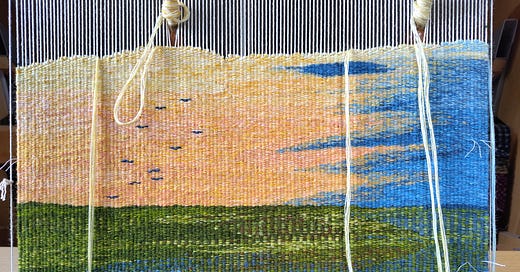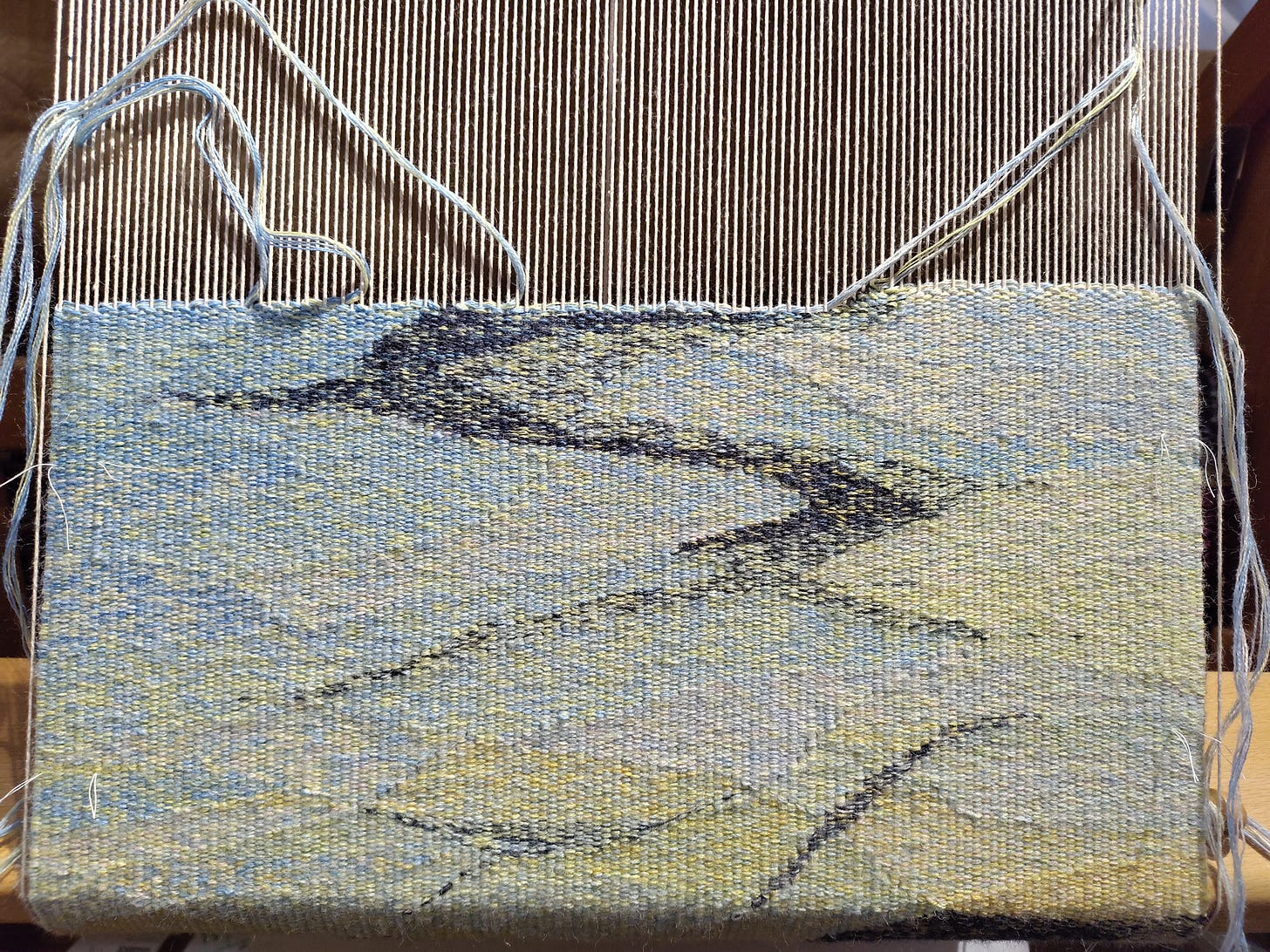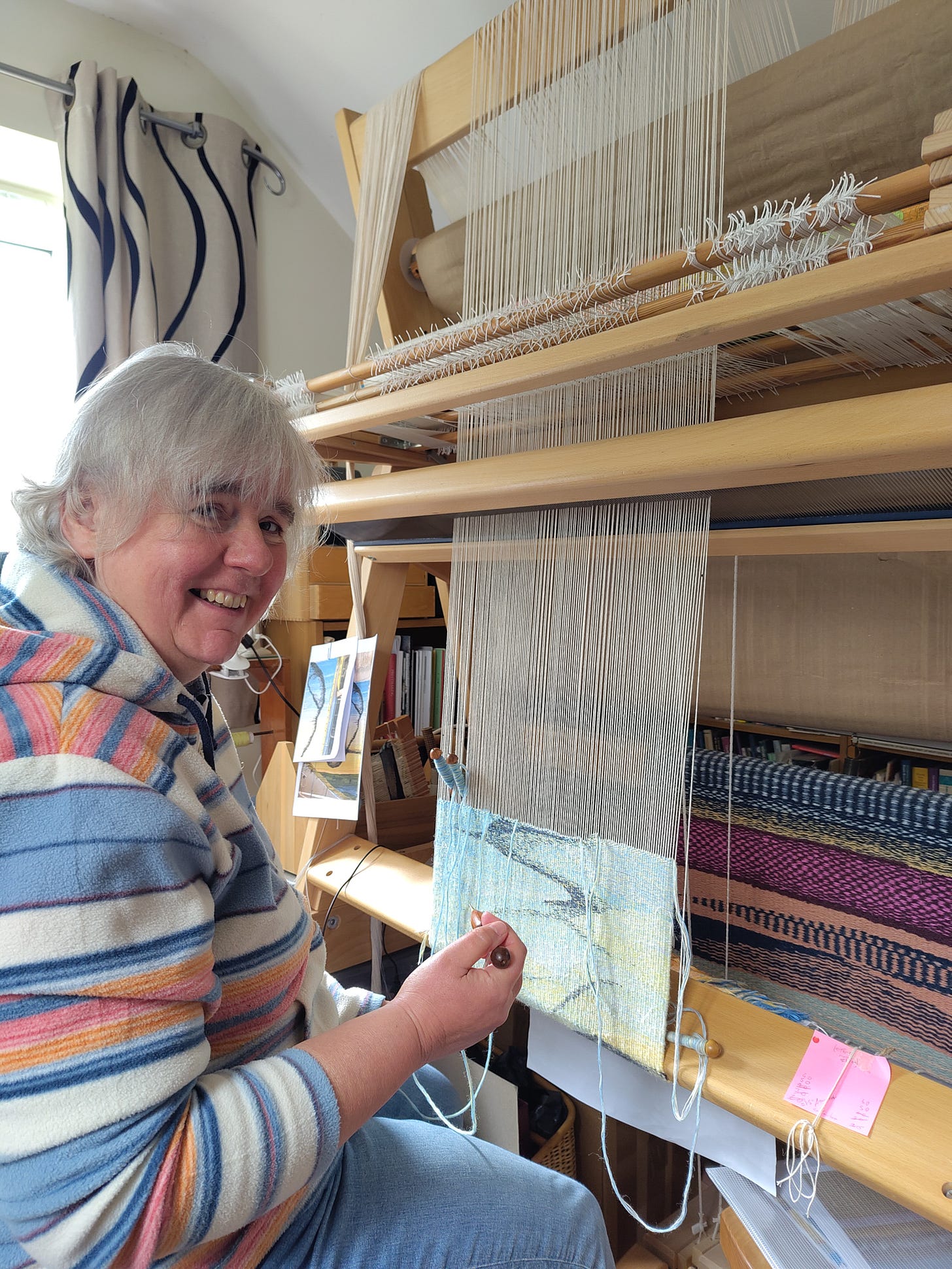All images by Anna Wetherell
I live in Cumbria, UK, amongst the Howgill Fells. Landscape, geology and water create foundations for my creative practice, reflecting my former career in nature conservation. I am exploring ways to integrate the two sides of who I am – the scientist and the artist – asking questions, developing a visual language, exploring different means of communication, but especially through the medium of woven tapestry.
I am one half of Nearly Wild Weaving – you can read Irene’s Murmuration blog in another part of this Substack. Tapestry weaving now forms a core part of my life, talking about tapestry weaving with others, running workshops, facilitating activities related to tapestry, but always with a link back to the natural environment. I even manage to weave sometimes.
The Waterline project was a key moment. Working with the inspirational Joan Baxter as well as the wider group of weavers, coming together with others to create a work that was so much more than the sum of its parts. The opportunity to continue to work with this wonderful group of weavers couldn’t be ignored, especially with the topic of a Murmuration.
Here in Cumbria we have several locations where murmurations occur regularly. The large flocks of starlings coming to roost in the reedbeds at Leighton Moss are well known, along with those over the limestone near Sunbiggin Tarn. We have even had mini-murmurations here in Sedbergh with our own, much smaller, flock of starlings. But I have seen other bird species do it as well: flocks of wading birds along the shoreline, especially knot; lapwing rising up above the fields; jackdaws and rooks flocking together before they roost. The patterns they make are mesmerising, a moment of awe.
The design for my tapestry was fairly constrained. My section is long and narrow. Minna and Jenny were well ahead of me in getting started, and had used contrasting elements for parts. They had recorded the yarns they used at different points, so I could make sure the blends that I used would match, creating a link between my neighbours. I could see the techniques they had used for their murmurations, and I knew where they would enter and leave my tapestry. I wanted a section that dipped into the landscape, and we agreed that our landscape would be a reed bed, a common habitat for murmurations. So I kept the design fairly simple in outline, and worked largely without a cartoon. The reedbeds and murmurations needed to join up; the shaped top and bottoms to my tapestry needed to flow into my neighbours; the colours and blends needed to work together - but other than that I had a free hand, and wove freely. I was inspired by how the others had woven their sections, especially the flowing shapes used by Christine, and brought those ideas in as I wove.
There have been many delights in the project – working with a wonderful group of weavers again, seeing designs and tapestries emerge, sharing and learning from each other. The constraints to my tapestry were also a delight, and I enjoyed the challenge of creating something within the bounds of colour, form and flow, ensuring that my section would slot in almost seamlessly, while still retaining its individuality. The difficulties go alongside and often become delights. Working on a collaborative project such as this is not to be underestimated. It is hugely challenging, dealing with team working in a practice where we so often work alone; developing an over-arching design that everyone was happy with; being clear about deadlines and timelines; being considerate of one another as our own lives shift over the two years of the project – and that’s so far. We still have the challenges of continuing the trail of exhibitions and communicating this project. Out of all this comes the delight of finding solutions and learning how to work together, as well as creating an amazing design. I write this just after we have seen the tapestries on the wall, together, for the first time – I hope everyone who sees it will be as amazed, inspired and delighted as we are!
My hopes and aspirations for Murmuration as we move forward into the next phases of the project? That we can find more exhibition venues to be able to show this wonderful work; that it travels to the States and Canada, and elsewhere; that we continue to work together and develop those friendships. It was wonderful to see how the Waterline project expanded horizons and skills, and Murmuration has built on that. Who knows what will come after this?
Image: Stuart Wetherell








Lovely to hear about your murmurating journey when you spend so much time encouraging others 😉. Walking into the gallery at Hillswick really took my breath away - such a beautiful achievement. I encourage everyone to try to see this work at Farfield Mill, Aberlady and all further points.
On non-starling murmurations - a flock of purple sandpipers over a rocky shore on the Northumbrian coast - pattern/ blur / pattern. - just as Anna has captured in her weaving.